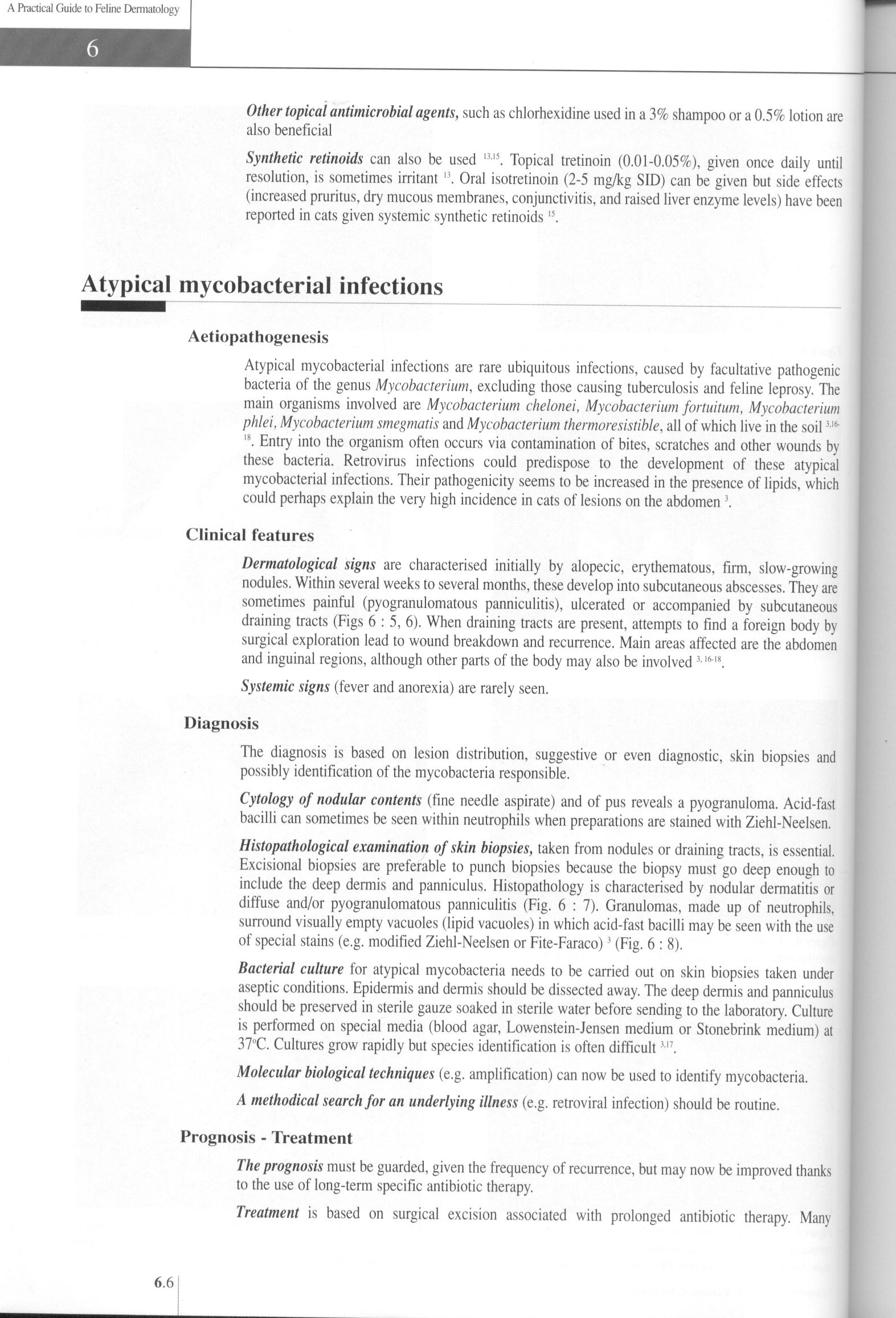65 (127)

6
A Practical Guide to Feline Dermatology
Other topical antimicrobial agents, such as chlorhexidine used in a 3% shampoo or a 0.5% lotion are also beneficial
Synthetic retinoids can also be used 13-15. Topical tretinoin (0.01-0.05%), given once daily until resolution, is sometimes irritant Orał isotretinoin (2-5 mg/kg SID) can be given but side effects (increased pruritus, dry mucous membranes, conjunctivitis, and raised liver enzyme levels) have been reported in cats given systemie synthetic retinoids15.
Atypical mycobacterial infections
Aetiopathogenesis
Atypical mycobacterial infections are rare ubiąuitous infections, caused by facultative pathogenic bacteria of the genus Mycobacterium, excluding those causing tuberculosis and feline leprosy. The main organisms involved are Mycobacterium chelonei, Mycobacterium fortuitum, Mycobacterium phlei, Mycobacterium smegmatis and Mycobacterium thermoresistible, all of which live in the soilli(h ,8. Entry into the organism often occurs via contamination of bites, scratches and other wounds by these bacteria. Retrovirus infections could predispose to the development of these atypical mycobacterial infections. Their pathogenicity seems to be increased in the presence of lipids, which could perhaps explain the very high incidence in cats of lesions on the abdomen \
Clinical features
Dermatological signs are characterised initially by alopecic, erythematous, firm, slow-growing nodules. Within several weeks to several months, these develop into subcutaneous abscesses. They are sometimes painful (pyogranulomatous panniculitis), uleerated or accompanied by subcutaneous draining tracts (Figs 6 : 5, 6). When draining tracts are present, attempts to find a foreign body by surgical exploration lead to wound breakdown and recurrence. Main areas affected are the abdomen and inguinal regions, although other parts of the body may also be involved3- 1<M8.
Systemie signs (fever and anorexia) are rarely seen.
Diagnosis
The diagnosis is based on lesion distribution, suggestive or even diagnostic, skin biopsies and possibly identification of the mycobacteria responsible.
Cytology of nodular contents (fine needle aspirate) and of pus reveals a pyogranuloma. Acid-fast bacilli can sometimes be seen within neutrophils when preparations are stained with Ziehl-Neelsen.
Histopathological examination of skin biopsies, taken from nodules or draining tracts, is essential. Excisional biopsies are preferable to punch biopsies because the biopsy must go deep enough to include the deep dermis and panniculus. Histopathology is characterised by nodular dermatitis or diffuse and/or pyogranulomatous panniculitis (Fig. 6 : 7). Granulomas, madę up of neutrophils, surround visually empty vacuoles (lipid vacuoles) in which acid-fast bacilli may be seen with the use of special stains (e.g. modified Ziehl-Neelsen or Fite-Faraco)3 (Fig. 6 : 8).
Bacterial culture for atypical mycobacteria needs to be carried out on skin biopsies taken under aseptic conditions. Epidermis and dermis should be dissected away. The deep dermis and panniculus should be preserved in sterile gauze soaked in sterile water before sending to the laboratory. Culture is performed on special media (blood agar, Lowenstein-Jensen medium or Stonebrink medium) at 37°C. Cultures grow rapidly but species identification is often difficult317.
Molecular biological techniques (e.g. amplification) can now be used to identify mycobacteria.
A methodical search for an underlying illness (e.g. retroviral infection) should be routine.
Prognosis - Treatment
The prognosis must be guarded, given the freąuency of recurrence, but may now be improved thanks to the use of long-term specific antibiotic therapy.
Treatment is based on surgical excision associated with prolonged antibiotic therapy. Many
6.6
Wyszukiwarka
Podobne podstrony:
58 (148) 5 A Practical Guide to Feline Dermatology severity of the illness. High titres are seen wit
67 (125) 6 A Practical Guide to Feline DermatologyNocardiosisAetiopathogenesis Nocardiosis is a very
69 (119) 6 A Practical Guide to Feline DermatologyDiagnosis The diagnosis is based on lesion distrib
710 (2) 7 A Practical Guide to Feline DermatologyHerpesvirus infections Dermatological manifestation
74 (105) 7 A Practical Guide to Feline Dermatology ulcerated. Lesion distribution is multicentric bu
27 A Practical Guide to Feline Dermatology Perianal glands 1.7 Permethrin 3.12, 3.13 Persian 1.6,2.2
27 A Practical Guide to Feline Dermatology Stemphyllium spp. 5.1,7.8 Stereotypie behaviour 17.1,
272 (16) 27 A Practical Guide to Feline Dermatology Alternaria spp. 5.1,7.8 Aluminium hyroxide 15.6&
274 (18) 27 A Practical Guide to Feline Dermatology Colitis 11.2 Collagen 1.2,2.6,12.1,
278 (17) 27 A Practical Guide to Feline Dermatology I J Histoplasmosis 5.8, 7.8, 25.2 Homer’s syndro
28 (374) 2 A Practical Guide to Feline Dermatology Configuration of lesions Determining the configur
313 (14) A Practical Guide to Feline Dermatology The second phase consists of long-term control of t
31 (328) 3 A Practical Guide to Feline Dermatology Sarcoptic mange Sarcoptes scabiei var canis (Tabl
82 (128) 8 A Practical Guide to Feline Dermatology considered important parasites. Cats in the Unite
42 (226) 4 A Practical Guide to Feline Dermatology Increased hydration and subsequent maceration of
44 (228) 4 A Practical Guide to Feline Dermatolog) The term “asymptomatically infected cat” refers
46 (213) 4 A Practical Guide to Feline Dermatology from cats with untreated infections are often pos
48 (209) 4 A Practical Guide to Feline Dermatology Table 4:1: Type of hair invasion, fruiting bodies
510 (5) A Practical Guide to Feline DermatologyCoccidioidomycosisAetiopathogenesis Coccidioidomycosi
więcej podobnych podstron